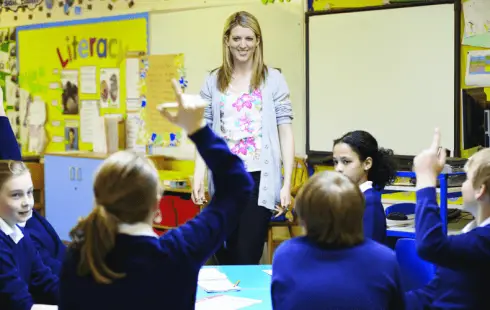
Custom T-Shirts: Last-Minute Gifts They'll Actually Love
Section: Arts
 The shortage of educators in German schools has emerged as a critical and persistent issue with no apparent resolution in the near future. Despite predictions extending into the next decade, there exists a significant disparity in forecasts, introducing an element of uncertainty.
The shortage of educators in German schools has emerged as a critical and persistent issue with no apparent resolution in the near future. Despite predictions extending into the next decade, there exists a significant disparity in forecasts, introducing an element of uncertainty.
According to estimates from the Conference of Ministers of Education and Cultural Affairs (KMK), the teacher shortage appears less severe than projections by education economist Klaus Klemm and the German Economic Institute (IW). The variance arises partly from the KMK's optimistic anticipation of a higher number of future teaching graduates, a viewpoint disputed by other experts who argue for a more conservative estimate.
Despite differing projections, a consensus acknowledges the emergence of a substantial teacher deficit from the mid-2020s onward, escalating over the next decade. Klaus Klemm projects a shortfall of nearly 80,000 teachers by 2035. Unfilled positions reported by states at the commencement of the current school year accentuate the severity, especially pronounced in East Germany and worsening in West German federal states.
The root cause of the teacher shortage lies in the miscalculation of student enrollment, stemming from the incorrect estimation of student numbers and subsequent insufficient teacher training. Initial expectations anticipated a continued decline in student numbers due to low birth rates, a trend that persisted for a considerable period. However, a reversal in birth rates since the 2010s, coupled with a recent increase in student enrollment, has defied previous assumptions. This shift has particularly impacted primary schools, with projections indicating a subsequent strain on secondary schools, especially in the critical Mint subjects.
While the number of teachers has seen some increase in recent years, certain regions, such as Thuringia and Saxony-Anhalt, have witnessed a decline. The impending wave of retirements, especially in the aging teaching workforce of eastern Germany, further exacerbates the situation.
The age profile of teachers in eastern German states, though generally high, is undergoing rejuvenation across Germany. Nevertheless, the influx of younger teachers alone is insufficient to address the widening teacher gap, attributed to factors beyond increasing student numbers, including the growing need for support for low-performing students, migrants learning German, and extended periods of education.
Efforts to alleviate the teacher shortage have sparked debates, notably the proposal to limit part-time opportunities for teachers, who currently engage in part-time work more frequently than other professional groups. Despite concerns that this measure might provide short-term relief while deterring potential young female educators, suggestions abound for a more sustainable solution.
The pressing need for quick action to mitigate the teacher shortage has led to an increased reliance on lateral entrants - individuals without traditional teaching degrees. This trend, especially prevalent in eastern Germany and at schools facing acute shortages, raises concerns about the qualifications and preparedness of these newcomers. Calls for uniform standards and scrutiny of initial qualifications are becoming more pronounced.
To address the teacher shortage comprehensively, there is a collective call to train more teachers, notwithstanding uncertainties related to birth rates, immigration, and educational reforms. The increase in new students pursuing teaching, observed since 2016, experienced a dip in both 2021 and 2022. The extended duration of teacher training, spanning approximately eight years from the commencement of the course to employment, contributes to the challenge. The "teacher funnel" data indicates a significant drop-off, particularly in the early semesters, emphasizing the need for improved study guidance, mentor support, and practical relevance.
Several additional proposals have been put forth to bridge the teacher gap, including lifetime working time accounts, increased utilization of digital teaching, the involvement of master's students, recruitment of foreign skilled workers, and specialized single-subject teachers. However, careful implementation is crucial to ensure these measures have a positive impact without compromising the quality of education. Without such careful planning, the education system may face emergency measures such as larger class sizes, reduced timetables, or even a four-day week for students.

Section: Arts

Section: Arts

Section: Business

Section: Business

Section: Arts

Section: Health

Section: Arts

Section: News

Section: News

Section: Arts
Health Insurance in Germany is compulsory and sometimes complicated, not to mention expensive. As an expat, you are required to navigate this landscape within weeks of arriving, so check our FAQ on PKV. For our guide on resources and access to agents who can give you a competitive quote, try our PKV Cost comparison tool.
Germany is famous for its medical expertise and extensive number of hospitals and clinics. See this comprehensive directory of hospitals and clinics across the country, complete with links to their websites, addresses, contact info, and specializations/services.
One of the most beautiful squares transforms into a summer stage every year for two days. The Gärtnerplatz Open-Air features a free music and cultural program across three stages, as well as street food from local vendors. On Saturday, the main stage at Gärtnerplatz offers something for everyone,...



No comments yet. Be the first to comment!